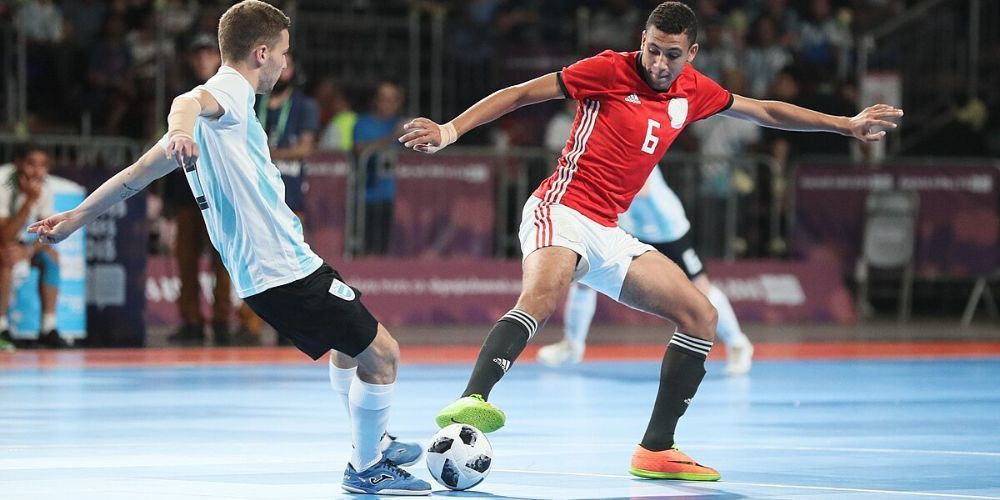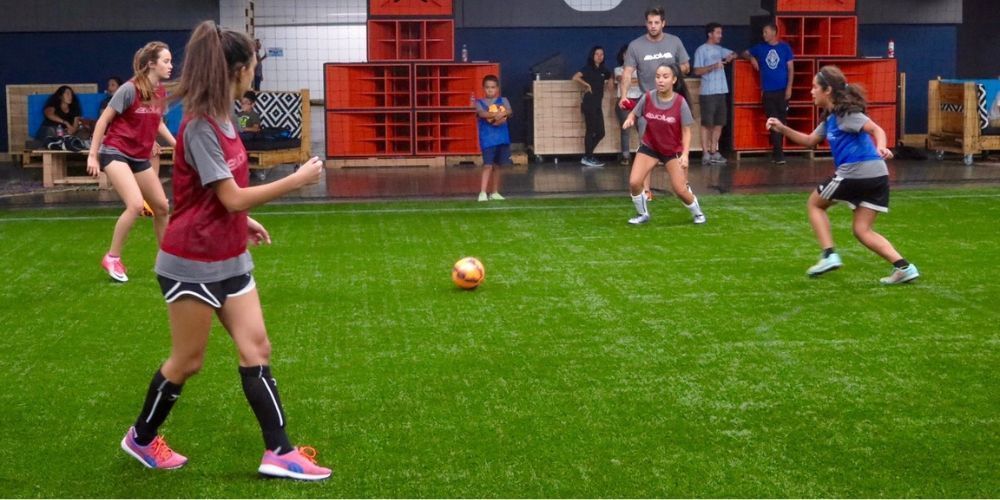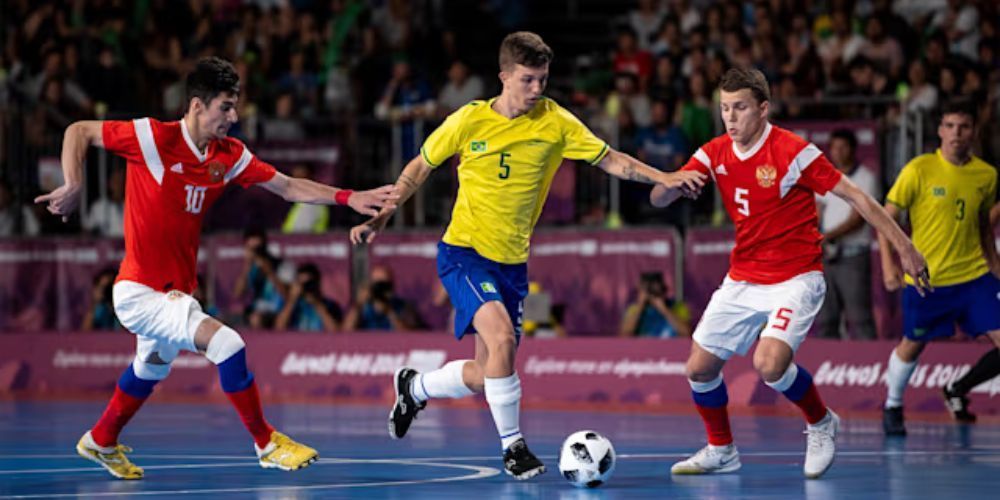Futsal's Rise: How Indoor Soccer is Growing in Popularity
September 18, 2024
Futsal and traditional soccer share the same passion but differ significantly in their structure and rules. Imagine soccer as a sweeping epic film and futsal as an intense short story. Both offer thrilling narratives but in uniquely captivating ways. To understand these differences, let's explore how futsal is played on a smaller indoor pitch with five players per side, emphasizing quick decision-making and ball control unlike the broader outdoor field of traditional soccer, which prioritizes stamina and strategic positioning.
In recent years, there has been a noticeable increase in futsal's popularity across various continents. This rise stems from its unique features that cater to both players seeking skill enhancement and fans craving continuous action. For instance, the 2021 FIFA Futsal World Cup reported higher average goals per game compared to traditional matches, making it more engaging for spectators. Furthermore, being an indoor sport makes futsal less subject to weather disruptions—a significant advantage for consistent community programs. Exploring this trend can provide valuable insights and data to bolster your advocacy for including futsal in local sports initiatives.
The rise of futsal is driven by several factors, including FIFA's promotional efforts, its inherent appeal due to fast-paced gameplay, and the recognizable skill development benefits it provides for players. Additionally, the organization of significant tournaments like the FIFA Futsal World Cup has increased visibility and engagement, thereby attracting more fans and participants to this exciting variant of indoor soccer.

Futsal vs. Traditional Soccer
At its core, futsal is designed to maximize player engagement and skill development. The smaller team size—just five players per side as opposed to eleven—means each player is required to be more involved in both offensive and defensive plays. This increased involvement nurtures players' skills, especially in terms of ball control, as they navigate tighter spaces with fast-paced movements. Players quickly learn to think on their feet; decisions must be made rapidly because the smaller area limits time for reflection.
In contrast to this intense focus on individual actions, traditional soccer requires players to thoughtfully leverage team strategies over extended distances.
A notable aspect of traditional soccer is the emphasis on stamina and positioning. With larger field dimensions ranging from 90 to 120 meters long, players are often required to cover significant ground during a match, which can impact their ability to maintain high energy levels throughout the game. Rather than emphasizing spontaneous decision-making, which is crucial in futsal, traditional soccer players must understand formations and positional play. This distinction shapes how teams train; futsal training tends to prioritize technical skills under pressure, while soccer practices may focus more on fitness drills and tactical planning.
Another critical difference lies in how fouls and free kicks operate; these rules contribute significantly to the gameplay dynamics.
In futsal, each foul benefits the opposing team directly through a free kick that takes place just outside the penalty area, leading to quick restarts and fluid gameplay. Conversely, traditional soccer employs a more complex foul structure with various restart scenarios like indirect or direct free kicks based on the nature of the foul and where it occurred on the pitch. This results in longer stoppages and more strategic buildup plays between teams.
It’s fascinating to see how both sports reflect distinct philosophies—futsal embraces a fast-paced game focused on immediate action, while traditional soccer builds towards team coordination over time.
As we explore these facets further, it becomes clear that both formats have unique strengths but also serve different player development goals.
Moreover, statistical insights reinforce these distinctions. Studies indicate that players engage approximately 30% more during futsal matches compared to their outdoor counterparts due to the nature of play. In an environment where quick thinking is paramount, players hone vital skills that translate well into traditional soccer. Many professional footballers attribute their early success—particularly regarding footwork and creativity—to their foundations in futsal.
This nuanced understanding not only highlights the unique characteristics of each sport but also paves the way for exploring how they influence player development strategies across different environments.
Advantages of Futsal
One of the most notable advantages of futsal is the speed of play. With a smaller pitch and only five players on each side, the game is inherently fast-paced. This leads to continuous action and more scoring opportunities, making every match exhilarating. Unlike traditional soccer, where games can sometimes feel slow with long ball passes, futsal keeps everyone on their toes, and players must think quickly and act even faster. It offers a thrilling experience for both the athletes on the court and those watching from the sidelines.
Another benefit is the emphasis on touch and technique. The futsal ball is smaller and harder, which means players must develop superior control and precision in their ball handling. This focus on skill fosters an environment where creativity shines. Young players gravitate to futsal because it allows them to hone their technical abilities in a dynamic setting. Aspiring footballers often credit their agility and finesse to futsal experiences, mentioning they learned how to navigate tight spaces, deceive defenders, and execute intricate plays.
The indoor nature of futsal also presents its own unique benefits.
Playing indoors mitigates the impact of weather conditions on gameplay. Rain or shine, snow or sleet, futsal games can go ahead without fear of postponement or cancellations. Fans appreciate that they can cheer on their teams regardless of the season, maintaining a consistent schedule for leagues and minimizing disruptions.
Speaking of fans, let's talk about how futsal enhances the spectator experience.
When it comes to engaging spectators, futsal truly excels. The close proximity of players to the audience creates an intimate atmosphere that doesn’t exist in larger outdoor stadiums. Spectators can feel a part of the action—the shouts from players, the thud of the ball, and even the intensity in athletes’ faces are all experienced at a personal level. Not only that but with games averaging about 5.79 goals per match during events like the 2021 FIFA Futsal World Cup, fans are treated to a show filled with excitement compared to traditional soccer’s less than three-goal average.
These compelling elements contribute to its rise in popularity and highlight its appeal as both a player’s game and an exciting event for viewers who love high-paced action.
Skill Development in Futsal
Futsal’s rapid pace and confined playing space push young athletes to elevate their game quickly. Players often find themselves confronted with tight quarters, where quick decision-making is essential and every touch of the ball counts. This environment nurtures skills that soccer demands yet are often overlooked in outdoor play. For instance, players typically touch the ball between 600 to 1,000 times per match, compared to only 50 to 100 touches in a standard soccer game. This frequent interaction with the ball enhances their comfort and confidence, resulting in better overall control.
As one coach emphasizes, “In futsal, a player must think two steps ahead. You can’t just boot it down the field; every moment matters.”
This heightened engagement fosters not just individual dribbling techniques but also improved passing accuracy and tactical awareness. Research indicates that futsal training can increase passing accuracy by 25% over just 12 weeks, demonstrating its effectiveness in developing critical foundational skills. Players learn to navigate pressure, create space, and think creatively while engaging with their teammates—all vital attributes for success in soccer. Additionally, consistent futsal practice enables them to engage in an average of 30-40% more goal-scoring opportunities than peers focusing solely on traditional soccer tactics.
However, while some may raise concerns regarding specialization in futsal, it's essential to recognize that this sport provides a unique skill set allowing for a smoother transition into full-sized soccer fields.
Veteran players frequently affirm that their experience in futsal means they handle the dynamic pace of larger games much more easily. While traditional soccer emphasizes broad tactical gameplay, futsal hones specific individual traits like agility and creativity, creating versatile players adaptable across formats. What's crucial is not merely literature on the game, but actual gameplay experience; as legendary figures such as Messi and Ronaldo have shown, starting with futsal cultivates an innate understanding of ball dynamics that becomes invaluable on any field.
As the sport continues to rise both in participation and acclaim globally, its role in shaping future soccer stars becomes unmistakable.
With these foundational skills firmly established, we now turn our attention to how this indoor variant is expanding beyond local courts and gaining international recognition.

Global Growth of Futsal
Over the last few years, futsal has not only gained traction but also transformed into an essential component of football culture across various nations. This growth can be attributed to its infectious energy and adaptability, making it appealing for clubs, schools, and communities. The dynamic nature of futsal often draws in crowds, creating an electric atmosphere that mirrors larger-scale football events.
FIFA's report indicating that participation numbers have surged by 20% globally in just five years speaks volumes about this sport's increasing allure. The statistics hint at a burgeoning interest fueled by grassroots initiatives and an expansion of futsal programs within organized sports. Organizations like UEFA are leading the charge by promoting competitions and providing financial incentives to member countries, thus propelling the sport’s growth further.
Countries such as Brazil and Argentina remain at the heart of this revolution; they’ve long fostered a rich legacy in futsal. However, recent developments show that Europe is catching up rapidly with notable contributions from nations like Spain.
In Spain, for instance, futsal leagues have flourished, boasting professional structures that rival traditional football leagues. The success stories emerging from these leagues serve as templates for other countries looking to develop their futsal scenes. As young athletes witness how futsal plays a critical role in nurturing premier talent—like players who transition seamlessly into football—it becomes evident why investment in this format makes sense.
This rising acceptance forms an intricate narrative that binds communities together through sport while simultaneously fostering skills among youth. In fact, towns that implement futsal initiatives often experience increased youth participation in sports overall, creating a culture of fitness and teamwork. Moreover, this engagement isn't limited to boys only; numerous programs encourage girls to participate as well, which supports inclusivity in sports.
As opportunities continue to grow, the blend of cultural integration and expansive enthusiasm reflects a commitment to developing talent at all levels. This momentum paves the way for exploring how young athletes can take advantage of these emerging pathways in the sport.
Opportunities for Young Players
Futsal offers promising pathways for young talent aiming to make it in the world of professional sports. Its distinct format allows players to hone crucial skills in a shorter time frame compared to traditional soccer. The game’s rapid pace and smaller team size mean that each player is more involved, creating numerous opportunities for individual players to showcase their abilities. This aspect is particularly beneficial for young athletes looking to develop their technical skills and decision-making under pressure.
The smaller team size in futsal competitions means more opportunities for individual players to shine compared to traditional soccer. Each match typically includes just five players on each side, encouraging significant interaction with the ball. In contrast, a standard soccer team has eleven players, which can lead to less engagement for some members during gameplay. As a result, while playing futsal, young athletes frequently find themselves in situations where they must execute skills and make quick decisions, prompting faster development of these critical attributes.
Many youth academies now recognize the significance of futsal and include it as part of their training regimen. For instance, the renowned Barcelona Youth Academy integrates futsal training into their program specifically to enhance young players' on-ball skills and quick thinking. This integration allows youngsters to develop a greater understanding of spatial awareness and teamwork, both of which are essential when transitioning to larger formats like outdoor soccer.
The benefits experienced by players can be profound. Rachel Pang, a 16-year-old futsal player, emphasizes this point: “Playing futsal since I was little has given me the confidence and technical ability to stand out in soccer tryouts.” Her words reflect a common sentiment among youth players who have integrated futsal into their training—an improved sense of skill along with increased self-assurance on the field.
As more young talent emerges through futsal, structured leagues are becoming more prominent on the global stage, creating new avenues for aspirants looking to turn their passion for the sport into viable career paths. The transition from grassroots participation to competitive levels is an exciting evolution worth exploring further.

International Futsal Leagues
Various international leagues have emerged, transforming futsal from a recreational activity into a respected professional sport. These leagues provide a platform for talent while cultivating a passionate fan base eager to support their local teams. For instance, Spain’s Liga Nacional de Fútbol Sala (LNFS) and Italy’s Serie A Futsal are premier examples of how established footballing nations embrace this thrilling variant of soccer. These leagues foster competitive play that highlights the unique skills required in futsal, such as rapid decision-making, dexterity, and teamwork.
What sets these leagues apart from traditional football leagues is their acute emphasis on gameplay that is fast-paced and dynamic—perfectly showcasing the exhilarating nature of futsal. For players and fans alike, matches unfold as an exciting display of agility and strategy. Each game serves as a testament to the finesse involved in handling the ball within tighter spaces, which differs significantly from outdoor soccer.
| League | Country | Top Teams |
|---|---|---|
| Liga Nacional de Fútbol Sala (LNFS) | Spain | Inter Movistar, Barça, ElPozo Murcia |
| Serie A Futsal | Italy | Italservice Pesaro, Acqua&Sapone |
| Campeonato Brasileiro de Clubes de Futebol de Salão | Brazil | Corinthians Futsal, Magnus Futsal |
Attendance figures underscore the rising interest; for example, the LNFS boasts an average attendance of 3,000 per game, reflecting the growing popularity of futsal among spectators. Such numbers highlight that people are not merely passive consumers of this sport; they are engaged fans cheering passionately for their teams. Furthermore, media coverage has improved dramatically, contributing to broader exposure and excitement around the league's matches.
As futsal continues to professionalize and gain traction globally, its international leagues lay the groundwork for expanded reach and increased competitiveness.
With deeper integration into regional sports culture, these leagues enhance player visibility and nurture a new generation of futsal enthusiasts who will passionately support their favorite teams just as football fans do today. Now, let's explore what lies ahead for this dynamic sport.
Future of Indoor Soccer
The landscape for indoor soccer is evolving rapidly, driven by grassroots enthusiasm and institutional support. Futsal, in particular, stands at the forefront of this transformation. With larger audiences anticipated and increased funding from international organizations like FIFA and UEFA, we are witnessing a seismic shift in how the sport operates and is perceived. These organizations are not only expanding their outreach but also creating channels for newer generations to engage with futsal more actively.
One significant initiative includes facilitating the transition of outdoor venues into futsal pitches. This simple yet powerful measure opens up new opportunities for community engagement and participation. Imagine local parks transforming into vibrant arenas where young players practice their dribbling skills or where families gather to watch weekend matches. Such initiatives are pivotal because they embed futsal into the cultural fabric of communities, making it accessible to all levels of players, from beginners to aspiring professionals.
Analysts project that these changes will not go unnoticed; as engagement builds, competitions at all levels are likely to increase in frequency and visibility. This heightened activity will help bolster player development pathways, enriching the talent pool available for clubs and national teams alike.
Furthermore, digital streaming platforms play an essential role in this evolution. By broadcasting games and showcasing talent, they can capture audiences that might never have tuned into live matches otherwise. Social media channels amplify this effect by allowing fans to interact, share highlights, and become integral parts of their teams’ communities from anywhere in the world. It's becoming clearer that these platforms don’t just support existing fanbases; they create new ones.
Embracing Innovation
To further strengthen indoor soccer's future, embracing innovative training methodologies will be crucial. As experts note, “Futsal is set to become a centerpiece of global soccer culture…” In-depth training modules tailored specifically for futsal can enhance player skills significantly faster compared to traditional outdoor soccer training. Training techniques involving ball control, swift decision-making, and tactical awareness are particularly accentuated in futsal due to its fast-paced nature.
This approach emphasizes the importance of adapting to changing climates within sports; those who remain stagnant often fall behind.
The ripple effects of these initiatives have broader implications as well: as futsal grows in popularity, more youth participants translate into greater spectator engagement across ages and demographics. This multifaceted growth fosters a cycle of investment and interest that only boosts futsal’s status on the global stage.
Thus, it is evident that the future holds immense potential not only for futsal but for indoor soccer as a whole, driven by community involvement and enhanced visibility through technological advancements.
In light of these transformations and innovations, the rise of futsal presents an exciting opportunity for the sport’s future on both grassroots and professional levels. The ongoing support and engagement will undoubtedly pave the way for unprecedented growth in popularity.
What is futsal and how is it different from traditional soccer?
Futsal is a variant of soccer played indoors on a smaller, hard court with a smaller, low-bounce ball. Unlike traditional soccer, which is played outdoors on a large field with 11 players on each side, futsal teams consist of five players, including the goalkeeper. The smaller playing area forces players to develop quick decision-making skills, precise passing, and improved ball control. The game is fast-paced, with continuous action and fewer stoppages, making it exciting to watch and play.
Why is futsal becoming more popular worldwide?
Futsal’s rise in popularity can be attributed to several factors. Its fast pace, small team size, and indoor setting make it accessible to players of all skill levels and in various climates. It is a great training ground for young players to improve their technical skills, which has led to its adoption in soccer academies worldwide. Additionally, professional soccer players, like Lionel Messi and Neymar, have credited futsal for shaping their early development, which has brought even more attention to the sport.
What are the benefits of playing futsal?
Futsal provides numerous benefits for players. It improves technical abilities, including ball control, dribbling, and passing, due to the confined space and smaller teams. The fast pace enhances fitness and agility while promoting quick thinking and creativity on the ball. Futsal also encourages teamwork and communication, as players must constantly be in sync to maintain possession and create scoring opportunities. Additionally, its indoor nature allows for year-round play, making it a popular choice in regions with colder climates or limited outdoor space.
Check out the latest guides on soccer
Author: William Flaiz
All Rights Reserved | Sports and Nature Gear










